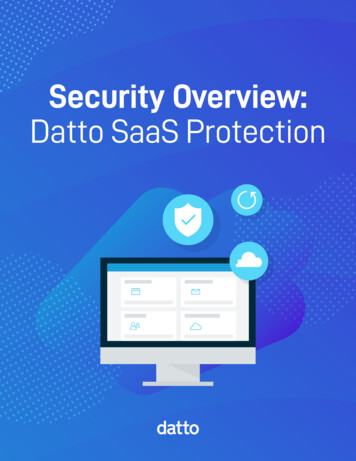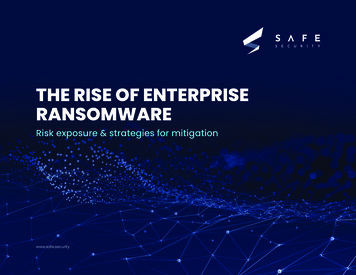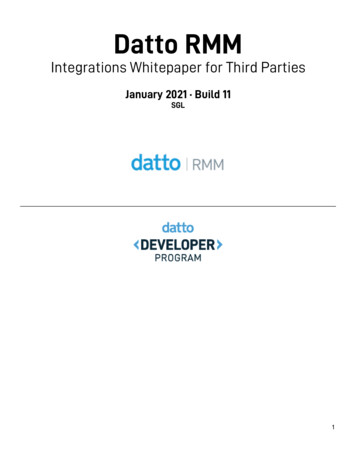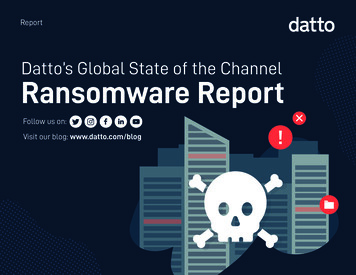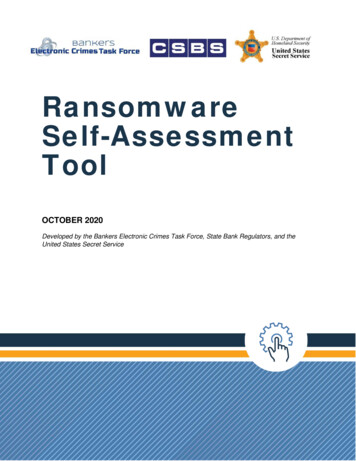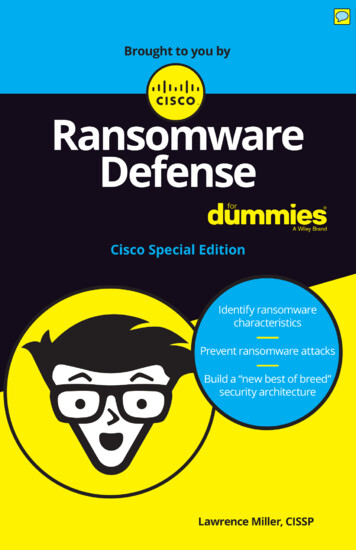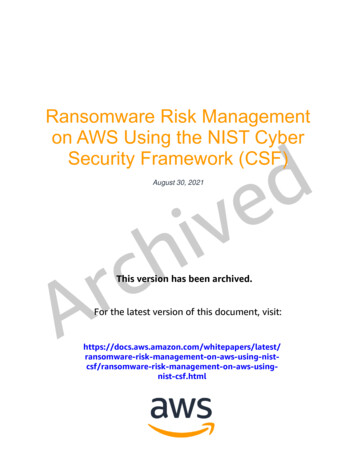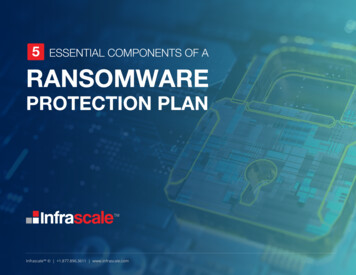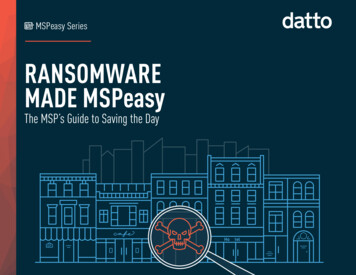
Transcription
MSPeasy SeriesRANSOMWAREMADE MSPeasyThe MSP’s Guide to Saving the DayHoopentel
RANSOMEWARE MADE MSPEASYRansomware TodayToday’s LeadingRansomware StrainsEducating Your CustomersAbout RansomwareRansomware by the NumbersConclusionRansomware has become a threat to individuals and businesses alike over thepast couple of years. A recent study conducted by security software vendorMcAfee Labs identified more than 4 million samples of ransomware in Q2 of2015, including 1.2 million new samples. That compares with fewer than 1.5million total samples in Q3 of 2013 (400,000 new).It seems unlikely that the use of ransomware will slow down any time soon.In the first three months of 2016, ransomware attacks increased tenfold fromthe entire previous year, costing victims more than 150 million. It’s become anepidemic. Ransom payment demands are typically fairly low—so many victimschoose to simply pay up and move on. As such, there is little interest in themalware among law enforcement. However, paying ransom can and should beavoided. So, ransomware represents an opportunity to educate current clientson cyber security best practices while generating new business opportunitiesfor MSPs.In this ebook, you will find information on the variety of ransomware in existencetoday and how it is spread. You’ll get practical advice from MSPs and IT securityprofessionals about how best to communicate the risk of ransomware to yourclients so they understand the importance of investing in security, backup andrecovery solutions.2 Ransomware Made MSPeasy
THE CURRENT STATE OF RANSOMWAREIn a recent MSPmentor podcast, Hal Lonas, CTO of security software providerIt used to be that the bad guyswanted data because it wasvaluable to them. With ransomwarethey’re essentially saying: ‘yourdata isn’t valuable to me, but howmuch is worth to you?’ It’s scaryhow smart it is.Webroot, offered a succinct explanation how ransomware has flipped thesecurity threat paradigm on its ear. “It used to be that the bad guys wanteddata because it was valuable to them,” he said. “With ransomware, they’reessentially asking: ‘your data isn’t valuable to me, but how much is worth toyou?’ It’s scary how smart it is.”There are a few dominant families of ransomware in existence today. Eachfamily has its own variants. It is expected that new types of ransomware willcontinue to surface as time goes on. This is because cyber extortionists areconstantly modifying ransomware code to evade detection by the most commondefense technologies, such as security software. This year, we’ve witnessed asurge in “polymorphic” malware, which is a variant that changes automaticallyas if to appear as unique to different endpoints. This is a major issue, because!!!!!!!!!!!Most ransomware uses the AES algorithm to encrypt files. To decrypt files,!!traditional security software often fails to discover singular variants.hackers typically request payment in the form of Bitcoins or alternate online!payment voucher services. The standard ransom demanded is about 375.Many variants also threaten that the ransom will exponentially increase if it notpaid within a 72 hour window, such as Jigsaw. “We’ve seen it bite clients withvarying severity,” said Frank Slattery of Teamlogic IT, a Massachusetts-basedmanaged services provider.Email is the most common method for distributing ransomware. It is generallyspread using some form of social engineering; victims are tricked intodownloading an e-mail attachment or clicking a link. Once the user takesaction, the malware installs itself on the system and begins encrypting files.3 datto.co.uk
In other cases, hackers install code on a legitimate website that redirectscomputer users to an alternative and malicious site. Unlike the SPAM emailmethod, this approach requires no additional actions from the victim.Today’s Leading Ransomware StrainsAs an MSP, it’s important to know the latest ransomware developments andwhether specific verticals are being targeted. The more informed you are,the better you can protect your clients’ data. There are a variety of forms ofransomware proliferating today. This is not meant to be an exhaustive list, but itwill give you an idea of what’s out there potentially affecting your clients.CryptoLocker: Ransomware has been around in some form for over a decade,but came to prominence in 2013, with the rise of the original CryptoLockerAs an MSP, it’s important toknow the latest ransomwaredevelopments and whether specificverticals are being targeted. Themore informed you are, the betteryou can protect your clients’ data.malware. While the original was shut down in 2014, the approach has beenwidely copied. So much so, in fact, that the word CryptoLocker has becomenearly synonymous with ransomware.Cerber: Cerber targets cloud-based Office 365 users and is assumed to haveimpacted millions of users using an elaborate phishing campaign. This typeof malware emphasises the growing need for SaaS backup in addition to onpremises.CryptoWall: CryptoWall first appeared in early 2014, and variants haveappeared with a variety of names, including: Cryptorbit, CryptoDefense,CryptoWall 2.0 and CryptoWall 3.0, among others.Crysis: This new form of ransomware can encrypt files on fixed, removable,and network drives and it uses strong encryption algorithms and a scheme thatmakes it difficult to crack within a reasonable amount of time.4 Ransomware Made MSPeasy
CTB-Locker: The criminals behind this strain take a different approach to virusdistribution, outsourcing the infection process to partners in exchange for aKeRanger is not widely distributedat this point, but it is worth notingbecause it is known as the firstfully functioning ransomwaredesigned to lock Mac OS Xapplications.cut of the profits. This strategy allows the malware to achieve large volumes ofinfections and generate huge profits for the hackers.Jigsaw: Jigsaw encrypts then progressively deletes files until ransom is paid.The ransomware deletes a single file after the first hour, then deletes more andmore per hour until the 72 hour mark, when all remaining files are deleted.KeRanger: KeRanger is not widely distributed at this point, but it is worth notingbecause it is known as the first fully functioning ransomware designed to lockMac OS X applications.LeChiffre: “Le Chiffre”, which comes from the French noun “chiffrement”meaning “encryption”, is the main villain from James Bond’s Casino Royalenovel who kidnaps Bond’s love interest to lure him into a trap and steal hismoney. GREAT name. Unlike other variants, LeChiffre needs to be run manuallyon the compromised system. Cyber criminals automatically scan networksin search of poorly secured remote desktops, logging into them remotely andmanually running an instance of the virus.Locky: Locky is typically spread via an email message disguised as aninvoice. When opened, the invoice is scrambled, and the victim is instructedto enable macros to read the document. When macros are enabled, Lockybegins encrypting a large array of file types using AES encryption. The spamcampaigns spreading Locky are operating on a massive scale. One companyreported blocking 5 million emails associated with Locky campaigns over thecourse of two days5 datto.co.uk
TeslaCrypt: TeslaCrypt also uses an AES algorithm to encrypt files.Typicallydistributed via the Angler exploit kit, this ransomware targets Adobevulnerabilities. TeslaCrypt installs itself in the Microsoft temp folder. When thetime comes for victims to pay up, victims are given options for payment: Bitcoin,PaySafeCard and Ukash. And who doesn’t love options?TorrentLocker: TorrentLocker isn’t new to the malware scene but the 2016version is more destructive than ever. Like the mononucleousis of ransomware,TorrentLocker, in addition to encrypting files, collects email addresses from thevictim’s address book to spread malware beyond the initially infected computer/network.ZCryptor: ZCryptor is a self-propagating malware strain that exhibits worm-likeProbably every one of our clientshas had some kind of experiencewith ransomware. But, many don’tunderstand exactly how to protectagainst it.behavior, encrypting files and also infecting external drives and flash drives so itcan be distributed to other computers.EDUCATING YOUR CUSTOMERSABOUT RANSOMWARE“Probably every one of our clients has had some kind of experience withransomware,” said David Tidwell, Help Desk Supervisor at Rigidnet, a Texasbased MSP and partner. “But, many don’t understand exactly how to protectagainst it.” Ransomware is a well known problem, but a lot of companies aren’tthinking proactively about it yet—especially smaller businesses. That’s a largemarket opportunity for MSPs.For example, many think about ransomware strictly as a security issue. But,that’s not entirely accurate. As ransomware is constantly evolving, it’s importantto make it clear to clients that they need a secondary layer of protection torecover, if malware slips through the security cracks - which it often does.6 Ransomware Made MSPeasy
Ransomware has made backup and security inseparable—each play animportant role in protecting against ransomware. As a trusted IT advisor, youI usually start the conversationwith something like ‘I don’t wantto scare or alarm you, but this issomething you need to think about.Just politely preface the subject.It’s not a hard sell — once youeducate, they get it.can help clients understand that a proper business protection strategy requiresa three-pronged approach, comprising education, security and backup.Education: Make sure that your customers know about the rise in ransomwareincidents and have tools and a strategy in place to educate their entireorganisation. For example, all current and new employees should have to gothrough some sort of basic cyber security training. During this training, SMBsshould provide specific visual examples of what a phishing email looks like,which is one of the leading causes of a ransomware infection. All employeesshould know how to spot a malicious email and know exactly what to do if theydo encounter a potential ransomware lure (i.e. don’t open attachments, if yousee something, say something, etc.). This is an essential part of protecting yourclients against attacks and it should become a fundamental practice in anybusiness today.According to Slattery, who has had his share of ransomware infections in thepast 2 years, “Given the speed of how rapid fire business works, it’s really hardto get people to slow down and think about what they are clicking on. Especiallywhen ransomware social engineering is as good as it is.” Slattery providescustomers with the ransomware statistics that matter most to them and thensegways into the technology needs. “I usually start the conversation withsomething like ‘I don’t want to scare or alarm you, but this is something youneed to think about,’” he said. “Just politely preface the subject. It’s not a hardsell—once you educate, they get it.”Security: When it comes to defending systems against ransomware, antivirussoftware is essential for any business. Firewall and web filtering are also a7 datto.co.uk
010101101010must. Most security vendors recommend this type of multi-layered approach toprotect against ransomware. Many of your clients probably already understandthis, as well. What they probably don’t realise is that these security measuresare not foolproof.MSPs should also talk to clients about the importance of keeping all softwarepatched and up-to-date in order to protect the business against newly identifiedthreats. Finally, make sure customers understand the need for an additionallayer of business protection in the not-so-rare case that ransomware doesmake it through the front lines of defense. Explain to your clients that even withthese proactive security measures, breaches still occur. That’s where a backupand recovery solution comes in.Finally, make sure customersunderstand the need for anadditional layer of businessprotection in the not-so-rare casethat ransomware does make itthrough the front lines of defense.Explain to your clients that evenwith these proactive securitymeasures, breaches still occur.That’s where a backup and recoverysolution comes in.8 Ransomware Made MSPeasyBackup: Modern total data protection solutions, like Datto, take snapshotbased, incremental backups as frequently as every five minutes to create aseries of recovery points and allow businesses to run applications from backupcopies of virtual machines. While your clients likely won’t care or understandthat sort of technical deep dive the way that you would, what they do care aboutis the benefits (and peace of mind!) a solution like Datto can deliver.Focus on the benefits of Datto rather than the features and innovation of thetechnology. When it comes to the threat of ransomware, the benefits of a dataprotection solution such as Datto are three-fold:1. Your business will never need to pay hackers ransom to get critical data back.2. Your business will avoid data loss - from ransomware or other - sincebackups are taken frequently and can be restored quickly.
3. Your business won’t experience significant downtime (since users canaccess critical data and applications while primary systems are beingWhen it comes to disaster recoverythese days, the biggest worryis someone on staff opening aninfected document, not a hurricane.Historically, a lot of businessowners didn’t think about this stuff,but that’s changing. People arestarting to recognize the threat.restored).“When it comes to disaster recovery these days, the biggest worry is someoneon staff opening an infected document, not a hurricane,” said Slattery. “It’sbecome a cornerstone of the discussion about BCDR. Historically, a lot ofbusiness owners didn’t think about this stuff, but that’s changing. Ransomwareis a big part of that change. People are starting to recognise the threat.”This is largely because there have been a number of high profile examplesof ransomware in the news, including a recent attack on a California hospitalin which cyber extortionists reeled in a ransom of 17,000 ( 12,800). This isobviously an extremely high ransom, but it illustrates the need for protection,so it might be a good place to start when it comes to discussions about cyberextortion.Both Tidwell and Slattery sell Datto alongside additional, less expensive backupoptions. They both said that they recommend Datto because it allows clients toget back online faster than the other backup tools they offer. “It’s a very easyconversation when you put it in the right context,” said Slattery. “Make sure theyunderstand that downtime equals lost revenue, and if they are concerned aboutthe price, compare revenue lost to the cost of the solution.”Slattery went on to say that it’s important not to push clients to go with a moreexpensive solution without a clear explanation. “It’s like: ‘look, I can have youup in minutes rather than all the time it will take with a cheaper solution whichmeans more revenue lost,’” he said. “It’s not about pressuring them, but youhave to make them aware of the realities of each solution, so they can make thebest decision for their needs.”9 datto.co.uk
Ransomware by the NumbersIf clients fail to understand how real the threat of ransomware is, you maywant to share some statistics with them. Here are five quick facts to pass on toreluctant clients:1. In just the first three months of 2016, attacks increased tenfold over all of2015, costing victims more than 150 million, according to the FBI. And,since so many ransomware attacks go unreported, this only represents afraction of actual attacks.2. In 2014-2015, around 27,000 corporate users were attacked. Comparethat with 2015-2016, when that number rose to 158,000. According tosecurity vendor Kaspersky Labs, this is because corporations can afford97% of malware today can morphto become unique to each endpointdevice—rendering traditional,signature-based security virtuallyuseless.to pay higher ransom and can not tolerate a complete loss of theirsystems.3. According to Webroot, 97% of malware today can morph to becomeunique to each endpoint device—rendering traditional, signature-basedsecurity virtually useless, and highlighting the need for backup.4. Webroot also reported that 100,000 net new malicious IP addresseswere created per day in 2015, up from 85,000 a day in 2014. indicatingcybercriminals are expanding to new IPs to avoid detection.5. According to threat management vendor PhishMe, the first three monthsof 2016 has seen a 6.3 million increase in phishing emails, due primarilyto a ransomware upsurge—a 789% increase over the previous quarter.10 Ransomware Made MSPeasy
CONCLUSIONRansomware protection fits right in with the proactive approach to monitoringRansomware attacks are happeningwith increased regularity—it’scertainly not trending downwards.It’s a big problem, but it’s also a bigopportunity to educate clients andgive them the tools they need toprotect their data.and managing client environments that MSPs deliver. Backup and security toolsthat integrate easily with remote management and automation software, ofcourse, make this a much easier task.For this reason, both Slattery and Tidwell said while they can support a varietyof backup and security solutions, they try to standardise as much as possible.For example, Slattery said TeamLogic recommends Trend Micro securitysoftware because of its integration with the AutoTask PSA software he uses.“Ransomware attacks are happening with increased regularity—it’s certainlynot trending downwards,” said Frank Slattery of MSP Teamlogic IT, DattoPartner. “It’s a big problem, but it’s also a big opportunity to educate clients andgive them the tools they need to protect their data.”010101101010You Also Might Be Interested In:Webroot White PaperStopping Crypto RansomwareInfections in SMBs11 datto.co.ukDOWNLOAD NOWeBookWebinarThe Guide to CryptoLockerPrevention and Removal15 Ways to FightCrypto RansomwareDOWNLOAD NOWWATCH NOW
McAfee Labs identified more than 4 million samples of ransomware in Q2 of 2015, including 1.2 million new samples. That compares with fewer than 1.5 million total samples in Q3 of 2013 (400,000 new). It seems unlikely that the use of ransomware will slow down any time soon. In the first three months of 2016, ransomware attacks increased tenfold .

